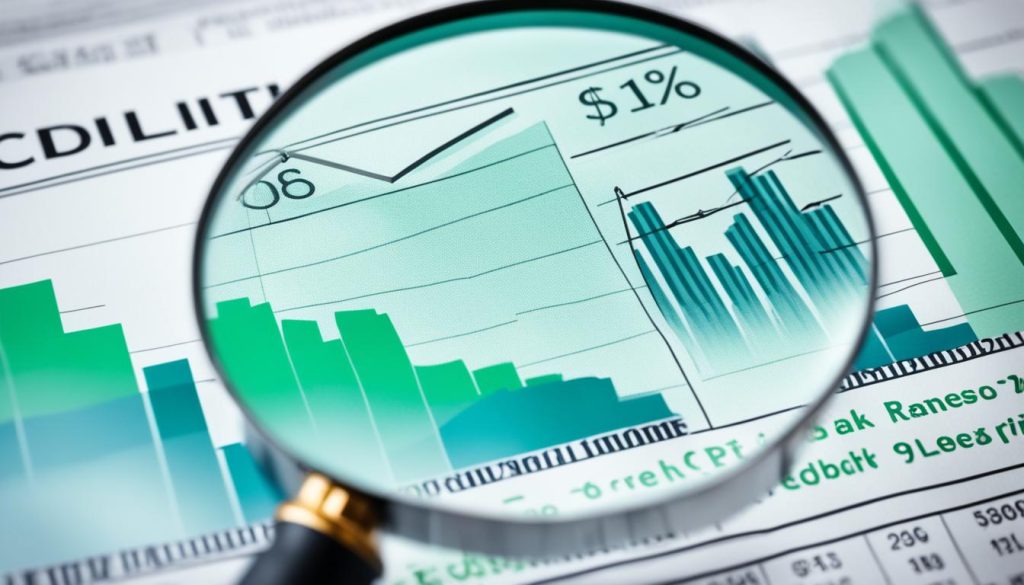The world of finance is all about taking smart risks. Credit risk, the chance a borrower won’t pay back a loan, is key. Lenders used to look at the “5 Cs” like Character, Capacity, Capital, Collateral, and Conditions1. But now, with big data and new tech, how we check and handle credit risk has changed.
This shift lets credit teams make better lending choices. It helps protect their money and lowers risks.
Key Takeaways
- The “5 Cs” of credit analysis – Character, Capacity, Capital, Collateral, and Conditions – are crucial in evaluating lending risks1.
- Alternative data analysis and open banking integration provide deeper insights into a borrower’s character and creditworthiness1.
- Cash flow analysis and machine learning models help assess a borrower’s capacity and likelihood of managing future debt1.
- Automated asset verification and debt-to-income ratio analysis reveal a borrower’s capital and debt burden1.
- Technology-driven solutions enhance credit risk management through automated scoring, real-time assessment, and personalized loan options1.
Introduction to Credit Assessment
Checking if someone or a business can pay back loans is key in lending. Credit risk assessment and creditworthiness evaluation help lenders make smart choices. They manage risks and build strong business ties. At the core, the “5 Cs” of credit analysis are used: character, capacity, capital, collateral, and conditions2.
Understanding the Significance of Credit Assessment
Credit analysis looks at a company’s debt payment ability through financial ratios and cash flow analysis2. It helps lenders guess the chance and extent of defaults. This aids in setting risk ratings for debt issuers or borrowers2. Also, it lets investors make money by guessing a company’s credit rating will get better2.
The “5 Cs” of Credit Analysis: Character, Capacity, Capital, Collateral, Conditions
The “5 Cs” are key for giving credit to customers. They help lenders see the risk of lending to a business. This affects interest rates, loan terms, and credit amounts given2. Knowing these helps credit teams make smart lending choices. It protects their money and helps build strong ties with borrowers.
- Character: Looks at the borrower’s reputation, honesty, and past credit history.
- Capacity: Checks if the borrower can make enough cash to pay back the debt.
- Capital: Looks at the borrower’s financial resources and how much debt they have.
- Collateral: Finds out the value and ease of using assets as loan security.
- Conditions: Looks at the big picture, like the economy, rules, and industry trends, that might affect the borrower’s repayment ability.
“The 5 Cs of credit form the crucial foundation for extending the credit limit to customers.”
Things like the law, competition, taxes, and global trends are also looked at in credit analysis2. This full view helps lenders make smart choices, reduce risks, and build strong lending portfolios.
Character Analysis: Unveiling the Borrower’s True Story
Advanced tech goes beyond just credit scores to understand a borrower’s true nature. By looking at social media and psychometric tests, lenders can see how a borrower handles money. They can also use open banking to see a borrower’s spending history3.
Alternative Data Analysis and Open Banking Integration
Looking at social media and psychometric tests gives lenders a full picture of a borrower4. With open banking, they can see a borrower’s spending history. This helps them understand the risks of lending to someone3.
Significance of Character Analysis in Credit Assessment
Character analysis through credit reports and scores shows a borrower’s financial past3. Advanced methods like Age-Period-Cohort modeling predict future default risks4.
Psychometric tests and behavior analysis reveal a borrower’s character traits5. This approach helps lenders make better decisions, leading to healthier loans and sustainable lending.
“By understanding a borrower’s character, lenders can make more accurate risk assessments and tailor their lending strategies to individual needs, fostering a more responsible and inclusive financial ecosystem.”
Capacity and Capital Analysis: Predicting Future Performance
Lenders look beyond just income when checking if someone can pay back a loan. They use advanced cash flow analysis and machine learning to guess if the borrower can pay in the future6. This checks financial ratios like profitability and liquidity to see how the borrower handles money6.
Cash Flow Analysis and Machine Learning Models
Looking at a borrower’s cash flow helps lenders understand their debt capacity. This info is key for making Probability of Default models, helping lenders know the risk and creditworthiness6. Machine learning finds patterns in this data that old methods might miss6.
Evaluating Financial Strength and Debt-to-Income Ratio
Lenders also check a borrower’s financial strength, like their balance sheet and reserves. This helps figure out potential losses if they default6. They watch the debt-to-income (DTI) ratio closely7. A DTI over 36% is seen as risky7. Those with strong finances and a low DTI are seen as safer, getting better loan terms7.
| Metric | Ideal Range | Implications |
|---|---|---|
| Debt-to-Income Ratio (DTI) | 36% or less | Lenders generally prefer a DTI around 36% or less, as a higher ratio indicates increased risk of default7. |
| FICO Score | 670 or higher | A good FICO credit score is typically considered 670 or above, with excellent scores above 800 and fair scores between 580 to 6696. |
| Down Payment | 20% or more | A down payment of 20% or more helps borrowers avoid private mortgage insurance, while loans with lower down payments may require additional collateral or guarantees7. |

By deeply analyzing a borrower’s finances, lenders can make smarter choices, manage risks, and figure out creditworthiness better. This approach lets lenders predict future performance and offer loans that fit the borrower’s financial situation67.
credit assessment: Collateral and Conditions
Understanding credit assessment means knowing what lenders look at when they check if you’re good for a loan. It’s not just about your character, how much you can borrow, and your money. Lenders also look at the value of what you own and the state of the economy and your industry. New tech like automated valuation models and tools for checking property from afar make checking what you own easier and safer for lenders.
Automated Valuation Models and Remote Property Assessment
Looking at what you own is a big part of figuring out if you might lose money if you can’t pay back the loan. Automated valuation models and remote property assessment tools help lenders quickly and accurately check what you own. This cuts down on the need for old-school appraisals8. These tools use data and pictures from space to see how much your property is worth and what shape it’s in. This lets lenders keep an eye on things in real time and manage risks better.
Understanding Macroeconomic Landscape and Industry Trends
Looking at the big picture, like the economy and your industry, is also key in credit assessment. Lenders need to get how the economy and your industry might affect you. By using economic data and info on market risks and your industry, lenders can guess what problems might come up and adjust their lending plans.8
| Collateral Analysis | Condition Analysis |
|---|---|
|
|
Using new tech and a full look at credit assessment helps lenders make smarter choices, lower risks, and match their lending to what borrowers need. This way of looking at credit, covering what you own and the big picture, helps lenders be more sure and precise.8

“Looking at collateral and conditions is key to making smart lending choices and avoiding risks.”
The Synergistic Power of Technology in Credit Assessment
Technology is changing how we assess credit, making new things possible. Now, automated credit scoring uses advanced algorithms to look at lots of data. This makes credit profiles more accurate and detailed. This real-time risk assessment9 helps lenders make quick, smart choices. It lets them see each borrower’s financial situation clearly.
Automated Credit Scoring and Real-Time Risk Assessment
Technology’s strength is in mixing old credit analysis with new data. This mix lets us do automated credit scoring. Machine learning looks at more info to give a better credit check. Adding open banking and other data10 makes this process even better. It gives lenders a deeper look into a borrower’s finances.
Personalized Loan Options through Data-Driven Insights
Technology does more than just check risks. It uses data-driven insights to offer personalized loan options. This makes loans fit the borrower’s needs better. It makes the lending process smoother for everyone involved9.
| Key Benefits of Technological Integration in Credit Assessment | Description |
|---|---|
| Automated Credit Scoring | Advanced algorithms look at lots of data for a better credit profile9. |
| Real-Time Risk Assessment | This makes quick, smart decisions possible, helping lenders match loans with borrowers’ needs9. |
| Personalized Loan Options | Uses data to make loans fit borrowers’ financial situations, making lending better9. |
Technologies like artificial intelligence and blockchain are changing credit assessment. They use automated credit scoring, real-time risk assessment, and personalized loan options. This makes credit risk management more accurate and customer-focused10.
“The true power of technology in credit assessment lies in its ability to combine traditional financial data with a wealth of alternative information, creating a comprehensive and nuanced understanding of a borrower’s creditworthiness.”
The credit industry is always changing, and technology will keep playing a big role. It will make lending more efficient, personal, and smart910.
Conclusion
Credit risk assessment is key for lenders to make smart and safe lending choices. The 5 Cs of credit analysis—Character, Capacity, Capital, Collateral, and Conditions—help a lot in this process11. New tech, like the Bank Statement Analyser, has changed credit assessment. It automates data, spots fraud better, and gives deeper insights into how people handle money12. This tech helps banks make credit assessments faster, follow rules better, and give customers a better experience. It also helps banks stay ahead in the changing financial world.
Using advanced tech, like machine learning and data analytics, has made credit risk modeling more accurate11. This means lenders can make better choices. It also makes lending more personal for borrowers11. As finance keeps changing, using credit assessment tech will be key for lenders to stay competitive.
Lenders can handle credit risk better by using credit assessment tools and the 5 Cs framework12. This approach makes lending more open and safe. It helps both banks and borrowers. It makes lending fair and efficient, which helps the whole financial world grow and stay stable.
FAQ
What are the “5 Cs” of credit analysis?
The “5 Cs” of credit analysis are Character, Capacity, Capital, Collateral, and Conditions. These factors help lenders understand the risk of lending to a business. They affect interest rates, loan terms, and how much credit a borrower gets.
How does technology revolutionize credit assessment?
Technology changes credit assessment by using new data like social media and open banking. It also predicts a borrower’s ability to repay loans with machine learning. Plus, it makes evaluating collateral easier with automated tools.
What is the significance of character analysis in credit assessment?
Character analysis looks at credit reports, scores, and repayment history. It shows a borrower’s past financial habits. This helps lenders understand the risk and make better loan decisions.
How do lenders assess a borrower’s capacity and capital?
Lenders check a borrower’s ability to repay by looking at their profits and cash flow. They also look at their financial reserves. This helps them predict the risk of default.
What role do collateral and conditions play in credit assessment?
Collateral analysis is about valuing assets and figuring out what lenders might get back if a borrower can’t pay. Condition analysis looks at market risks and trends. This helps lenders predict losses and make smart loan decisions.
How do technology solutions enhance the credit assessment process?
Technology uses the 5 Cs and more data for automated scoring and real-time risk checks. It offers personalized loan options based on the borrower’s finances. This makes lending more accurate, efficient, and follows the rules better.
Source Links
- Conquering Credit Risk: How 5C’s Play a key role in strategic decision making in Lending.
- What Is Credit Analysis? How It Works With Evaluating Risk
- Credit Review: Definition, Purposes, How to Read Them
- Credit Scoring: Which Personality Traits Predict Credit Risk?
- Understanding the Five Cs of Credit
- 5 Cs of Credit: What They Are, How They’re Used, and Which Is Most Important
- The 5 C’s of Credit: What They Are, How to Build Them – NerdWallet
- The Synergistic Power of CUCopilot and MS Copilot: A Game-Changer in Credit Union Operations – CU 2.0
- Blockchain and AI, A Synergistic Future • August 2024 | FreshCredit®
- What Is Credit Scoring? Purpose, Factors, and Role In Lending
- 5 Essential Credit Management Workflows – Conclusion

